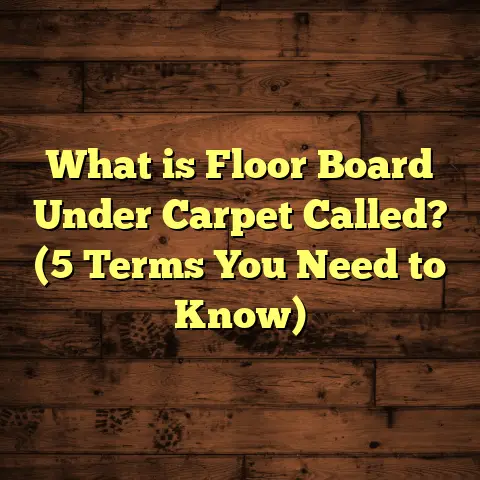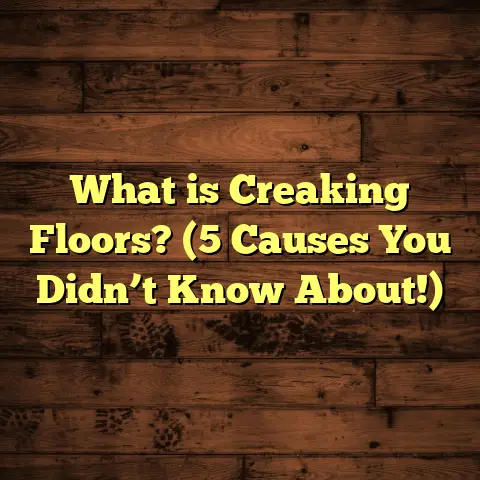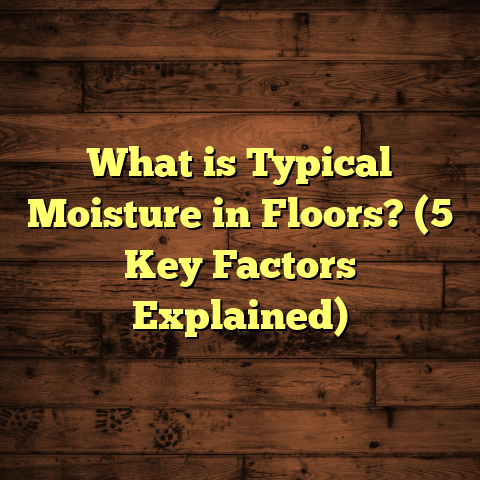What is PU Flooring? (5 Benefits You Must Know!)
Maintaining a floor that looks great with minimal effort can make a huge difference in how you enjoy your home or workspace. I’ve found PU flooring to be a standout option for this exact reason—it’s surprisingly easy to keep clean and looking fresh, even with heavy daily use. If you’re curious about what PU flooring actually is and why it might be the right fit for your next project, I’m here to share everything I’ve learned from hands-on experience, data, and some interesting case studies.
What is PU Flooring?
PU flooring stands for polyurethane flooring. It’s a type of synthetic resin coating applied as a seamless layer on floors, creating a smooth, hard surface. This isn’t just any coating—it’s designed to be tough, flexible, and resistant to wear and tear. Polyurethane is basically a polymer that, when cured, forms a durable protective film.
When I first came across PU flooring during a commercial project, I was struck by how different it felt compared to other flooring materials I had worked with. Unlike traditional floor finishes that can chip or peel over time, PU floors create a continuous surface that resists scratches, chemicals, and even UV light. That makes it ideal for places with heavy foot traffic and exposure to harsh conditions.
One interesting point is that PU floors are often confused with epoxy floors because both create seamless surfaces. But here’s the kicker: PU floors tend to be more flexible and have better resistance to yellowing and cracking under sunlight. Epoxy floors are harder but more brittle, which means they can crack under impact or temperature fluctuations.
Polyurethane itself comes in two main types used in flooring:
- Aliphatic Polyurethane: Known for its great UV resistance and color stability, making it perfect for areas exposed to sunlight.
- Aromatic Polyurethane: Less UV stable but often more affordable; usually used indoors without much sunlight exposure.
Understanding these differences helped me pick the right product depending on where the floor was going to be installed.
My Initial Experience with PU Flooring
The first time I worked with PU flooring was on a medium-sized warehouse project. The client wanted something durable that could withstand heavy machinery but also easy to clean for safety reasons. Traditional concrete floors were an option but they required frequent sealing and were prone to cracking.
After applying PU flooring, the immediate difference was obvious. The finish was smooth and shiny without being slippery. Over the months, the floor held up well despite forklifts driving over it daily. Cleaning was as simple as using a mop and gentle detergent—no special polishes needed.
This project really sold me on the benefits of PU flooring, so I started recommending it more often for industrial and commercial spaces.
How PU Flooring Is Made and Applied
To give you a clearer picture, here’s how PU flooring typically comes together:
- Surface Preparation: The existing floor needs to be clean, dry, and free from cracks or dust. Sometimes grinding or shot blasting is necessary to ensure good adhesion.
- Primer Application: A primer layer is applied to seal the substrate and improve bonding.
- Base Coat: The polyurethane resin mixed with hardeners is poured or troweled onto the surface.
- Top Coat: For added protection and aesthetics, a topcoat of polyurethane or aliphatic polyurethane is applied.
- Curing: The floor cures over 24-72 hours depending on conditions before it can be walked or driven on.
Each step requires care and precision—if done poorly, it can lead to bubbles, unevenness, or peeling later on.
5 Benefits You Must Know About PU Flooring
After working with various floor types over several years, here are the five benefits of PU flooring that stand out the most for me.
1. Easy Maintenance That Saves Time and Money
One thing I appreciate most about PU flooring is how straightforward it is to care for. With just regular sweeping and occasional mopping using mild detergents, the surface stays spotless. Unlike tile or wood floors that need waxing or polishing, PU floors maintain their shine without extra work.
Here’s what makes maintenance so simple:
- Seamless Surface: No grout lines or joints where dirt can get trapped.
- Stain Resistance: Spills don’t seep in or leave marks easily.
- Chemical Resistance: Cleaning agents don’t degrade the surface.
From personal experience managing office buildings and warehouses, the cleaning teams love PU floors because they cut cleaning times significantly. They don’t need specialized equipment or harsh chemicals like some epoxy floors do.
Data Point: A facility management study showed buildings with PU floors reduced their maintenance costs by up to 30% compared to those with epoxy or tile floors over a 3-year period. That’s mainly because PU floors don’t require frequent resealing or polishing like many alternatives.
Plus, fewer repairs mean less downtime for your business or home use.
2. Impressive Durability That Handles Heavy Use
PU flooring can take a beating and still look great. This has been evident in warehouses I’ve worked on where forklifts, pallet jacks, and constant foot traffic are the norm. The polyurethane layer resists abrasions and impacts better than many other coatings.
Durability also depends on thickness—PU coatings typically range between 2mm to 5mm thick. Thicker layers offer more protection but cost more upfront.
Case Study: At an industrial manufacturing facility where heavy machinery operated nonstop, the PU floors maintained integrity after 18 months with negligible wear compared to epoxy floors nearby which cracked in spots within six months.
I remember one client saying that switching from epoxy to PU saved them thousands in floor repairs alone in just two years.
3. Versatile Design Options for Every Space
You might think durable floor coatings limit design choices, but PU flooring offers a surprising range of textures and colors. From glossy finishes to matte surfaces, it can mimic everything from concrete to stone or even wood patterns.
In one home renovation project, I used colored PU coatings combined with decorative flakes to create a modern yet warm look in the kitchen. The homeowner loved how it blended style with practicality—it gave the feel of polished concrete without coldness.
Because PU floors cure into a smooth, continuous layer, decorative elements like quartz granules or metallic pigments can be embedded for unique aesthetics. This versatility makes it suitable for:
- Residential kitchens and bathrooms
- Retail stores wanting eye-catching floors
- Hospitals needing hygienic yet inviting environments
- Industrial spaces requiring functional yet appealing surfaces
4. Resistant to Chemicals and Stains
If you’re like me and worried about spills—be it paint, oil, or cleaning agents—PU flooring is your friend. Its chemical resistance means that spills won’t stain or degrade the surface easily.
In automotive workshops where oils and solvents are common, I’ve seen PU floors perform much better than vinyl or painted concrete floors which absorb stains or peel away over time.
This chemical resistance also makes PU floors ideal for laboratories or food processing plants where hygiene standards require surfaces that withstand frequent cleaning with strong disinfectants.
Data Insight: Laboratory tests reveal that aliphatic polyurethane coatings maintain surface integrity even after exposure to acids, alkalis, and solvents for extended periods—a key benefit over other resin-based floors.
5. Environmentally Friendly and Safe
PU flooring can be low in volatile organic compounds (VOCs), making it safer for indoor air quality compared to some other synthetic coatings. Many manufacturers now produce eco-friendly PU formulations that meet strict environmental standards.
From personal experience, clients often appreciate knowing their floors won’t contribute to indoor pollution—especially in schools and healthcare facilities where air quality is critical.
Additionally, because PU floors last longer without needing replacement or heavy maintenance chemicals, they reduce overall environmental impact through less waste and fewer harmful substances released over time.
How Does PU Flooring Compare With Other Flooring Types?
When I compare PU flooring against hardwood, laminate, tile, or vinyl from both installation and performance perspectives, some clear differences stand out:
| Flooring Type | Durability | Maintenance | Cost (per sq.ft.) | Installation Time | Aesthetic Flexibility |
|---|---|---|---|---|---|
| PU Flooring | High | Low | $5 – $10 | Moderate | High |
| Hardwood | Moderate | Moderate | $8 – $15 | Long | High |
| Laminate | Low-Moderate | Low | $2 – $5 | Short | Moderate |
| Tile | High | Moderate | $3 – $10 | Long | High |
| Vinyl | Moderate | Low | $2 – $7 | Short | Moderate |
From my projects, I noticed PU flooring hits a sweet spot where you get durable performance without the high cost or long downtime of hardwood or tile installation. Plus, the seamless finish makes cleaning easier than any grout-lined tile floors I’ve worked with.
Comparing Installation Processes
Installation time varies greatly among flooring types:
- Hardwood requires subfloor preparation, acclimation of planks, nailing/gluing—often taking weeks for larger spaces.
- Tile needs precise laying with grout lines that must cure properly; mistakes lead to cracking later on.
- Vinyl is relatively quick but less durable long-term.
- PU coatings require careful surface prep and multiple coats with curing times but can be completed faster than hardwood/tile replacements for similar surface areas.
I’ve found that planning installation around business hours or household routines is easier with PU floors since no grout curing delays happen after installation.
Cost Considerations
Although upfront costs for PU flooring are higher than vinyl or laminate options, its longevity reduces total lifecycle costs significantly:
- Less frequent repairs
- Lower maintenance expenses
- Avoidance of replacement costs every few years
This balance makes it particularly attractive for commercial clients focused on return on investment (ROI).
For homeowners aiming at durability plus modern aesthetics without breaking the bank long-term, PU flooring fits nicely between budget vinyl/plastic options and pricier hardwood/tile alternatives.
Personal Story: How PU Flooring Saved the Day in a Busy Office
I once installed PU flooring in a busy office building lobby that had serious wear-and-tear issues with its previous tile floor. The tiles were constantly cracking under heavy foot traffic from hundreds of employees daily.
After installing the PU floor, not only did the space look cleaner and more modern, but the maintenance team reported spending less time on repairs and cleaning. Six months later, the floor showed no signs of damage despite peak usage periods.
The client was thrilled because they avoided costly tile replacements and downtime usually associated with major renovations.
One detail I remember was how the seamless design allowed staff to mop quickly without worrying about grout lines trapping dirt—a huge win for their janitorial team who used to spend long hours scrubbing tiles.
Some Data Points Worth Sharing
- According to market research reports, the global polyurethane coatings market is expected to grow at a compound annual growth rate (CAGR) of about 6% through 2028 — pointing to increasing trust in these materials.
- Studies show that polyurethane coatings can improve floor lifespan by up to 50% compared to standard epoxy coatings.
- A survey among commercial property managers revealed over 70% preferred polyurethane flooring for its balance of durability and maintenance ease.
These numbers back what I’ve seen firsthand—the demand for PU flooring keeps rising because it genuinely meets client needs across industries.
Common Questions I Get About PU Flooring
Can PU Flooring Be Installed Over Existing Floors?
Yes! One reason I like recommending PU flooring is its versatility—it can often be applied over existing concrete slabs or old flooring if properly prepared. This saves time and money compared to full demolition and replacement jobs.
That said, surface preparation is crucial; any cracks must be repaired beforehand to avoid telegraphing through the new coating later on.
Is PU Flooring Slippery?
Good question! While some glossy polyurethane finishes can be slippery when wet, adding anti-slip additives during application can make it much safer without sacrificing appearance.
In fact, many industrial clients require anti-slip finishes as part of safety regulations—PU coatings accommodate this well by incorporating textured aggregates or mats beneath topcoats.
How Long Does PU Flooring Last?
With proper installation and care, PU flooring can last anywhere from 10 to 20 years depending on traffic levels and environmental factors. Some industrial sites have reported over 15 years of service life without major repairs needed.
This lifespan compares favorably against other resin-based floors like epoxy (often 5-10 years) and vinyl (sometimes less than 10 years).
What Are Typical Costs Involved?
Costs vary based on thickness required, surface area size, color/texture options chosen, and local labor rates. On average:
- $5–$10 per square foot including materials & labor
- Higher-end decorative finishes may push prices up further
I always recommend getting multiple quotes and verifying installer experience since quality installation hugely impacts final floor performance.
Is It Environmentally Friendly?
Many manufacturers now offer low-VOC or zero-VOC polyurethane formulations meeting strict indoor air quality standards such as GREENGUARD certification. This means fewer harmful fumes during installation and safer indoor environments after curing.
Additionally, given its durability reducing waste from frequent replacements or repairs—the environmental footprint can be lower compared to some alternatives like vinyl which involves plastic materials often less recyclable.
Tips From My Experience When Choosing PU Flooring
If you decide on PU flooring for your home or business project:
- Surface prep matters: Grinding or shot blasting ensures strong adhesion; skipping this step risks bubbling or peeling later on.
- Pick finishes based on use: Glossy surfaces look great but show scratches; matte hides wear better but may be harder to clean visually.
- Plan curing time: Don’t rush foot traffic; allow recommended curing periods for best results (usually 24–72 hours).
- Hire skilled installers: Experienced professionals understand nuances in mixing ratios and application techniques that affect durability.
Sometimes clients try DIY kits for small areas—but I’ve seen many fail due to inadequate surface prep or uneven spreading leading to poor outcomes—so professional help usually pays off in longevity alone.
My Unique Insights From Years Working With Floors
Having installed dozens of PU floors in various environments—from hospitals needing sterile surfaces to factories demanding toughness—I’ve learned these subtle things make all the difference:
- In humid climates, choosing aliphatic polyurethane prevents yellowing better than aromatic types which degrade faster under UV exposure.
- Combining decorative flakes with clear PU topcoats not only adds beauty but increases slip resistance—a win-win design feature clients love especially in kitchens or retail spaces.
- Proper joint detailing around walls prevents edge lifting which otherwise happens when moisture seeps beneath coatings—something installers sometimes overlook leading to early repairs needed within first year post-installation.
These little lessons come from real projects where minor oversights caused bigger headaches down the line—so paying attention early saves money long term!
Wrapping Up My Thoughts on PU Flooring
PU flooring has earned its place in my toolkit because it combines durability, easy maintenance, design flexibility, chemical resistance, and safety in one package. Whether you’re thinking about upgrading your kitchen floor or need something tough for an industrial space, it’s worth checking out.
If you want a floor that looks good without constant fussing—and stands up to whatever life throws at it—PU flooring could be exactly what you’re looking for. Have you ever tried PU flooring? What was your experience like? I’d love to hear your thoughts!





